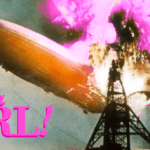 Technology
Technology  Technology
Technology  Humans
Humans 10 Everyday Human Behaviors That Are Actually Survival Instincts
 Animals
Animals 10 Animals That Humiliated and Harmed Historical Leaders
 History
History 10 Most Influential Protests in Modern History
 Creepy
Creepy 10 More Representations of Death from Myth, Legend, and Folktale
 Technology
Technology 10 Scientific Breakthroughs of 2025 That’ll Change Everything
 Our World
Our World 10 Ways Icelandic Culture Makes Other Countries Look Boring
 Misconceptions
Misconceptions 10 Common Misconceptions About the Victorian Era
 Mysteries
Mysteries 10 Strange Unexplained Mysteries of 2025
 Miscellaneous
Miscellaneous 10 of History’s Most Bell-Ringing Finishing Moves
 Technology
Technology Top 10 Everyday Tech Buzzwords That Hide a Darker Past
 Humans
Humans 10 Everyday Human Behaviors That Are Actually Survival Instincts
 Animals
Animals 10 Animals That Humiliated and Harmed Historical Leaders
Who's Behind Listverse?

Jamie Frater
Head Editor
Jamie founded Listverse due to an insatiable desire to share fascinating, obscure, and bizarre facts. He has been a guest speaker on numerous national radio and television stations and is a five time published author.
More About Us History
History 10 Most Influential Protests in Modern History
 Creepy
Creepy 10 More Representations of Death from Myth, Legend, and Folktale
 Technology
Technology 10 Scientific Breakthroughs of 2025 That’ll Change Everything
 Our World
Our World 10 Ways Icelandic Culture Makes Other Countries Look Boring
 Misconceptions
Misconceptions 10 Common Misconceptions About the Victorian Era
 Mysteries
Mysteries 10 Strange Unexplained Mysteries of 2025
 Miscellaneous
Miscellaneous 10 of History’s Most Bell-Ringing Finishing Moves
Ten World-Famous Businesses with Surprising Backstories
You may think you know quite a bit about some of the world’s most famous companies—what they advertise, what they sell, what they’ve achieved. After all, with many of the biggest Fortune 500 companies in the world, their brand is everywhere, with television commercials, online advertisements, billboards, and more. And with many of them selling products nationwide and around the world, there’s no doubt about who they are and what they offer.
But you’d be surprised to learn that not every massive, multi-national company of today started in the sector where they currently reside. In fact, many companies took many winding, uncertain turns through their early histories before landing on major profitability and long-term success.
In this list, we’ll take a look at ten world-famous companies that started out as very different versions of what they came to be. In all ten cases, had you followed these firms from the outset, you’d be shocked to see how they evolved into what they sell now!
Related: 10 Businesses Too Big to Fail That Totally Flopped
10 Adidas
Adolf “Adi” Dassler was a German-born businessman and the younger brother of another entrepreneur named Rudolf Dassler. In 1924, while Rudolf was busy with his fledgling business we now know today as Puma, Adi decided to build out his own company. So he founded a firm that produced textiles and related products for all of Western Europe. The firm—which was a combination of parts of Dassler’s first and last name—was a reasonable success for about 15 years, and Adi reached a decent level of social influence and cultural capital with it.
Then, World War II broke out. When the company opened in full by the late 1930s, and the Nazis began marching on the rest of Western Europe, Dassler was hired to make boots for the Germans. Adidas began going into full war-time production on behalf of the Nazis. That lasted until the end of the war and the near-total destruction of the German economy in the aftermath of the awful fight.
Dassler wasn’t ready to give up on business after the war, though. In 1949, as a 49-year-old man, Adi again started over. This time, he rightly recognized that there was a new, growing need for sportswear and athletic shoes marketed to post-war young people trying to live out some better days. He pushed hard to get into the sports footwear market, and from there, Adidas has grown to become one of the best-known brands in the world.[1]
9 NASCAR
NASCAR wouldn’t have been NASCAR had it not been for Prohibition. Down in the Deep South of the United States during the time when alcohol was banned in the early 20th century, moonshiners took to making illegal spirits and selling them on the black market. Of course, coming up with tubs and barrels of moonshine wasn’t just a complicated process as far as creating the drink goes—it was also difficult to get large quantities of it out to speakeasies and hopeful underground consumers. These moonshiners and rum runners needed some kind of reliable and subtle transportation system to ferry the illicit alcohol all over.
Enter renegade drivers. These young men would go all over the South in their high-powered (well, high-powered for the time period) cars with the backs filled with moonshine and illegal spirits. They raced from town to town and speakeasy to speakeasy, dropping off the drinks and outrunning cops who realized what they were doing. Soon enough, many of the drivers became very talented at navigating backroads, negotiating tight turns, and flying around blind corners. Even with angry police officers chasing behind, drivers made it out of difficult situations and rode to freedom—and profit.
One day, an enterprising businessman named Bill France noticed that the souped-up cars being used to make these moonshine runs were far more interesting than the moonshine itself. Prohibition was drying up, and alcohol was back on the list of legally allowable substances again. But France didn’t want the racing tradition born in the rural backwoods to come to an end just like that. So he cobbled together an idea: What if he took those moonshine drivers and got them on a track somewhere together to see who was the fastest and most talented?
The NASCAR we all know today was born in the 1940s with that very idea at its core. The organization’s first officially sanctioned race happened at Daytona Beach in 1948. Then, in 1949, it settled in Charlotte, North Carolina—a hometown the organization still has today. Since then, stock car racing has blown up nationwide and even in other parts of the world. But it didn’t start out that way; it was born from a Prohibition-era alcohol push first and a racing circuit only years later.[2]
8 Nokia
Nokia didn’t start out as a tech company when it was founded. That’s because the “tech” we all know and love today wasn’t even a thing way back then. In 1865, a Finnish man named Knut Fredrik Idestam founded what we now know as Nokia in the city of Tampere. Then a part of the Russian empire, Tampere was a place where paper mills were flourishing at the time. Idestam was a mining engineer by trade, but he saw an opportunity to make some money in the paper business. He set out to work in order to supply the rest of Europe with their increasing demand for paper products.
For a long time, Nokia did just fine as a paper mill and production factory in Tampere. But almost a full century later, in the 1950s, competition started to set in all over the region. The paper market in that area became oversaturated with competitors, and many of those competitors had deeper pockets to wait out the smaller guys like Nokia. Idestam’s successors realized their firm was on the route to bankruptcy with so much local competition, so they decided to pivot.
In the early 1960s, recognizing the slow but steadily increasing demand for electronic products around Europe, Nokia started re-training all its paper mill workers on electrical engineering projects. The gamble worked. They began by producing cables meant for these new-fangled electronic gadgets. Over the next several decades, Nokia took the lead in producing the gadgets themselves as they hired even more specialized workers and saw their profits soar. Of course, the modern-day story for Nokia isn’t nearly as rosy as the second half of the 20th century was. Still, their ascension to tech mobile phone dominance in and around the 1980s proved to be a far cry from the firm’s background in paper.[3]
7 Twitter
Twitter wasn’t even an idea in the mind of founder Jack Dorsey until his prior project failed in the early 2000s. Dorsey had wanted to start a podcasting platform called Odeo—created originally by Noah Glass—and turn it into a popular audio-sharing and listening source well before the mass popularity of things like iTunes. But Odeo never quite got off the ground, even though it had a host of employees at the time who were true believers and worked hard to make it happen. It also didn’t help that Apple released iTunes at the same time.
When Odeo came up as a dud in the early 2000s, Dorsey then pivoted his focus onto what he initially thought would be an SMS-messaging service. In his mind, Twitter was meant to be a short-form messaging service that could handle tiny, text-only missives. They wanted to offer a way for people to communicate around the globe in short, clipped messages. That’s why the earliest tweets were limited to 140 characters—they were clipped so they could be sent off as SMS messages.
The old staff from Odeo was mostly on board with Twitter’s direction, even if they weren’t quite sure about what it would become. They remained loyal to Dorsey and felt he had the goods to deliver what—at the time—was supposed to be a pretty simple idea. Of course, Twitter has long since grown so far beyond that. It’s not just the character count (or the employee count) that has grown, either. At the time Twitter was officially launched in 2006, there’s no way Dorsey could have ever thought it would be central to media, entertainment, politics, and culture after only a few short years of use.[4]
6 Procter & Gamble
There is no bigger manufacturer of consumer goods around the world today than Procter & Gamble. Go into the bathroom, linen closet, or kitchen of your home right now and take a look at the products and items you have on the shelves. Chances are that many of them were made by the conglomerate known the world over as Procter & Gamble. The firm holds dozens and dozens of brands under its empire and boasts yearly profits in the billions. They are everywhere, and it seems like they make nearly everything.
Of course, you can’t start a business that way—making everything under the sun. And in P&G’s case, things had much more humble beginnings than what we see today. It all started in 1837 when a candlemaker named William Procter was introduced to a soapmaker named James Gamble. Their wives were sisters, so the men were acquainted with each other in that way. And the sisters’ father—both men’s father-in-law—recognized early on what the rest of us now know: They each had unique talents and minds for business.
So, that year, the father-in-law pushed the two specialty item makers to open a store together in Cincinnati, Ohio. At first, they made exactly what each man knew how to make: soap and candles. The business did well enough selling those two products, and it wasn’t long before the fellas wanted more. They started producing other consumer goods as time allowed. They also bought up other local businesses and hired other expert workers—things were growing now. Now, nearly two full centuries later, Cincinnati’s soap-and-candle shop is one of the world’s biggest and most profitable companies.[5]
5 SEGA
The company that would one day become known worldwide as SEGA didn’t start out that way—and it didn’t even start out in Japan. Many people don’t realize that SEGA was actually founded in 1940 in Hawaii by four American men. Martin Bromley was at the head of that charge that year—not long before Pearl Harbor and the U.S. entrance into World War II. He called the company Standard Games, intending to make slot machines and music boxes for Americans at military bases all across the Pacific. For a while, that was a successful-enough enterprise. And when the war was raging, and scores of American men were shipped off to outposts all around that vast ocean, Bromley’s company did pretty brisk and consistent business with the military.
But after the war ended, the military business that had been bustling declined. Soldiers were sent home, and Bromley’s brand took a hit. Then, it took an even greater hit in 1952, when the American government banned slot machines. That ban was overturned just a few years later, but it was the death knell for Bromley’s venture.
Seeking an exit, Martin started trying to export slot machines to Japan. At the time over there, they were in very high demand. Bromley was able to export a decent amount of the machines to Japanese cities, but that sector didn’t prove to be as much of a hit for the Hawaiian as he had hoped. After a little more than a decade in the export business, Bromley wanted out for good. In 1965, he sold Standard Games to a Japanese entrepreneur who quickly renamed it SEGA.
At first, the newly-branded SEGA turned its focus toward hardware components for games. And when the 1980s rolled around, it had the manufacturing know-how and assets to go headlong into the booming video game industry. Today, of course, we know SEGA as one of the early gaming industry’s most prolific brands and consoles, with characters like Sonic the Hedgehog famous all over the globe. But it all started as a slot machine company—and an American-made one at that![6]
4 Raytheon
It’s easy to hear the name “Raytheon” today and think of a shadowy defense industry giant that produces military equipment and machinery for big bucks. And while government defense contracts are truly a major source (OK, practically the only source) of Raytheon’s modern-day success, the brand very much didn’t start out that way. Instead, Raytheon was founded way back in 1922 by three men: Vannevar Bush, Laurence Marshall, and Charles Smith. At the time, they wanted to build a successful company that would produce appliances for American homes—namely ice boxes, refrigerators, and microwave ovens.
For a while, that worked pretty well. In fact, it worked very well; Raytheon’s researchers were the first team to successfully invent and produce a microwave oven. The time it took to cook and reheat food was cut down in the name of efficiency, and suddenly, homes had ways to make hot dishes in mere minutes because of their work.
But after World War II, Raytheon’s executives noticed something interesting: They could get much more money by going after government contracts to produce military technology. The company had all the scientists and researchers it could want to figure out new tech. And the big bucks were coming from the American government and its allies as the Cold War fight loomed and then took hold in the middle of the 20th century. From there, Raytheon has become one of the most well-known and profitable defense manufacturers out there. But the founders’ intentions were initially very different![7]
3 Coca-Cola
We may know Coca-Cola today as a soft drink brand recognized and loved worldwide. But when it was first introduced in the late 1880s, it was meant to be used as a medicine. Its inventor was a man named John Stith Pemberton. He was a chemist and a Civil War veteran. Following his time on the battlefield in that brutal war, he became addicted to morphine. And considering he worked in a pharmacy, he had easy access to that drug—and no sign of a desire to slow down from the addiction.
Well, eventually, he realized it was best to curtail his heavy use for years. So, in the early 1880s, he started experimenting with various versions of coca wine. In 1885, he finally found what he thought was the perfect mixture. However, it contained alcohol, and a prohibition period descended upon the U.S. in 1886. So, looking to mass-market the drink, Pemberton took out the spirit and re-marketed the brand as a non-alcoholic drink called Coca-Cola.
He intended the drink to be sold to people who had been addicted to morphine and other drugs, like what he himself had experienced. But soon after he launched the beverage, newspapers caught on, and the public followed suit. By late 1886, Pemberton realized that the public enjoyed the taste of his drink, even if they weren’t after it for its medicinal properties related to morphine addiction.
Thinking quickly, he re-marketed the beverage once again over the next few years. He also altered its ingredients one more time to capture even more attention from the non-morphine-addled public. This time around, he took out some of the medicinal substances and replaced them with more sugar—and, yes, cocaine. Obviously, there’s no cocaine in the drink today (wouldn’t that be something?), but by 1892, the sugar-based refreshment had finally settled on what would push it to worldwide fame.[8]
2 Samsung
Today, everybody on planet Earth knows Samsung as one of the biggest electronics companies in the world. The firm has hundreds of thousands of employees spread out worldwide. Just like all companies of its size, it only ever seems to keep growing as it continues to pick up market shares in the ever-competitive global electronics market. But things didn’t start out that way for the firm and its founder, Lee Byung-chul.
Back in 1938, Lee decided that he wanted to open up a small grocery store in his hometown of Seoul, South Korea. At first, things seemed to be getting along just fine for him until other competitors started opening up around his neighborhood. Soon, the area was oversaturated with grocery stores—and Lee was struggling to stay afloat amid all the competition. History dealt him a nearly fatal blow, too, when, in 1950, the Korean War broke out. Prices surged, products became scarce, and Lee’s store nearly went bankrupt.
Lee knew he needed to save the business. So he made a pivot: Instead of being a simple grocery store, the market would now only sell sugar and textiles. For a few years through the 1950s, that worked well enough to keep him afloat. Then, as the Korean War started to slow down, Lee’s business once again waned. But this time, having experienced the importance of being flexible and open to change once before, he was ready for it. By the early 1960s, he rightly recognized that electronics were on the way up. He jumped into the business of manufacturing and selling electronics long before other firms recognized their impant. Nearly overnight, he began to dominate that market—and Samsung has only grown from there.[9]
1 DuPont
The company known now as DuPont has gone through many changes in the two centuries it’s been around. It started back in 1802, and at the time, it was based in France. The firm was one of France’s leading gunpowder manufacturers back then. Their products were very much in demand around the world, and the family behind its founding accumulated great wealth from their holdings in such a lucrative wartime industry. Soon after that, the company moved to the United States, but even as it did, it remained in the business of war. It would primarily make gunpowder and other explosives for more than a century. Even though it began to branch out just before World War I, it continued to make smokeless powder for fighters on the front lines of that awful conflict.
After World War I and into the middle of the 20th century, DuPont began to change its business model. Multiple corporate reorganizations occurred, as did major research projects to push new products out into the world. During World War II, DuPont scientists researched and developed plutonium that was used in the Manhattan Project. The company helped develop and produce things like rayon, too—and the firm even won multiple Academy Awards for its role in developing super-sensitive panchromatic film for the early movie-making industry in Hollywood.
Today, you probably know DuPont as the company that makes Teflon-coated products. Pots and pans all around the house nowadays boast of their guaranteed, no-stick Teflon coating that’ll prevent food from being grafted onto the dish while cooking. That’s a DuPont creation and one that radically altered their business in the eyes of the general public compared to the gunpowder-producing gigs they started with two centuries ago.[10]








